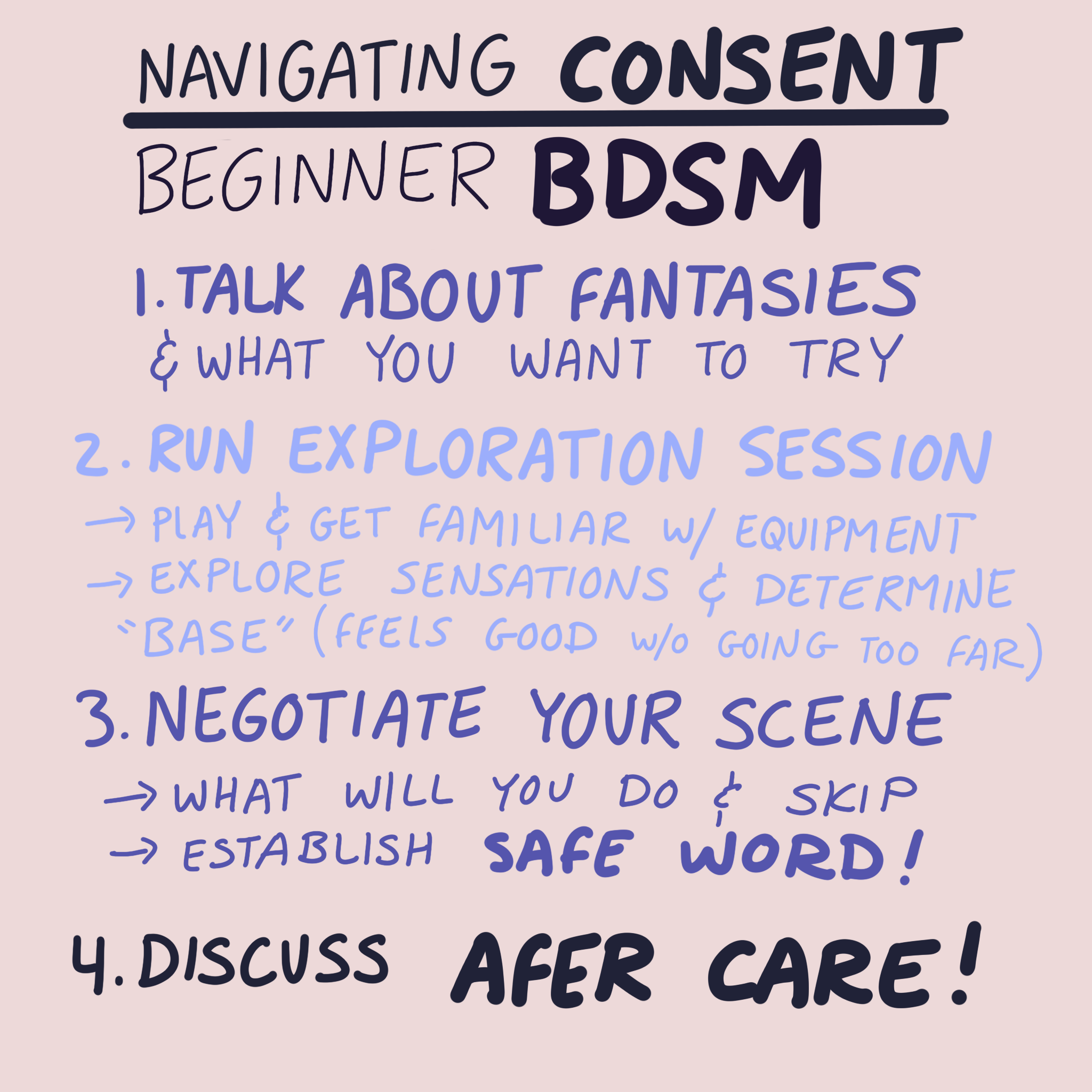Consent for BDSM
Consent applies to all intimate interactions. With that said, there are certain types of experiences that require more layers of communication and planning to keep everyone physically and emotionally safe. When it comes to BDSM, having rigorous consent practices can establish the difference between pleasure and abuse. So what do you need to keep in mind?
Before You Play
Get to know your play partners
It’s no secret that the foundation of BDSM is trust. Whenever you enter spaces where there are intentional changes to social norms and disregard of normative dynamics, you need to make sure that everyone is on the same page. It’s important to find play partners that will treat you with care and respect outside of a scene in order to feel safe enough to fuck up that dynamic during a scene. For example, you can’t role play disrespect if you’re being disrespected by your partner outside of a scene. Remember, the fun part about BDSM is getting to play out fantasies that we normally wouldn’t get to do in real life. If you can’t establish trust and safety with a potential play partner, they aren’t the right person for you. Finding a good play partner is crucial, but getting to know your play partner is even more important. You need to fully understand each other’s motives, interests, and limits before you start playing together. So once you’ve found a potential match, start talking! Discuss your fantasies, your experience level, your fears, your limits, and most of all ask them questions so you understand what they’re all about.
Note: If you’re a beginner, it’s crucial to disclose this information. Unfortunately, many people put themselves and their pals into incredibly risky, if not downright dangerous, situations because they go further than their skill set. BDSM is absolutely not a “fake it ‘til you make it” type of activity. Do your homework, play at your experience level!
Run exploration sessions
Depending on the type of BDSM activity you wish to practice, you’ll need to learn how to use equipment, learn necessary skills, and establish baselines with your play partners. Baselines refer to a comfortable amount of sensation for any given activity. For example, spanking can seem like a relatively straight-forward activity. Butt once you start your exploration session, you’ll notice that everyone has different preferences as well as different responses to sensation. You can’t safely increase sensation or push tolerance unless you know your baseline. You also can’t assume your play partner will automatically know what feels good and what feels like too much until you’ve told them. It’s also important to practice skills and discover exactly what you crave. Going back to our example, some people like straight forward OTK with bare hands, while others will realize they would rather explore other forms of impact play. If you’re using equipment like paddles, straps, whips, canes, etc you’ll need to understand how to properly use them. The goal of an exploration session is for you and your pal to practice. If you’re brand new to kink, this is a crucial step! Fantasies are not reality, it can be hard to discover if you actually like a certain type of play if you’ve never tried it. Exploration sessions allow you and your pals to discuss what sensations feel good, what doesn’t, and to make any necessary adjustments!
Note: the difference between an exploration session and a scene is largely in the intention. When I have exploration sessions with pals, I expect a lot more discussion in the moment. I’m asking many either/or questions to understand how to successfully adjust my technique. I might also take classes with pals as part of exploration sessions to learn more information on the practice we’re trying out. By contrast, a scene is usually negotiated ahead of time and contains practices that my play partners and I are familiar with.
Negotiate your scene
Once you and your play partner know each other, have established trust, and have had an exploration session, you can start to negotiate scenes. A scene negotiation is pretty straight forward, it establishes the parameters of the games you want to play together. Remember, BDSM is essentially a game, which means you and your pals need to establish the “rules” that you want to abide by. You can describe the power dynamic you’re interested in exploring, decide the specific acts that you want and don’t want, establish safe words and safe signals, discuss what equipment you’ll use, and describe the psychological and emotional states that you want to experience. All negotiations should be done within an equitable power structure, meaning everyone involved must have the ability to freely advocate for their desires and needs. Even if you’re playing with D/s dynamics, this should not override everyone’s fundamental right to assert themselves during scene negotiations. Scene negotiation conversations are the appropriate time to raise any concerns you have as well as creating a safety plan. Safety plans include obtaining the necessary tools to deal with potential injuries or emergencies. For example, if you’re practicing bondage you need EMT shears on hand in case you need to cut your partner out of their restraints without stabbing them.
Remember, anything that isn’t discussed during a scene negotiation should not be practiced during your scene. If you only said you were okay with impact play during negotiation, it’s not appropriate to decide to try spontaneous bondage during scene. You can always try that another time, but everyone needs to have space to decide what they want before they’re put into a scene, ESPECIALLY if power-based role play is prevalent in your scene. Of course, folks who have more experience or who have been playing together for a long time might not need to go through such a rigorous discussion process, but if you’re new to BDSM, trying a specific discipline for the first time, or haven’t played with someone before, scene negotiations are an important step to establish consent and safety.
Lastly, you’ll want to discuss your aftercare plan. It’s important that everyone who plays together feels safe and cared for following a scene. People can experience drops following their play, so knowing how to physically, emotionally, and psychologically care for one another is crucial. Decide if you’ll spend the night together, go out for dinner, cuddle, or whatever else. You might also need to have processing conversations together depending on the type of play you’re doing, so setting up a time to have those conversations is also a good idea. Discuss what will feel good for you during and after your scene to make sure you and your pals will want to continue playing together. Good plans = good play!
Note: Safe words are really useful communication short cuts. They’re also necessary if you’re playing with consensual non-consent (CNC) wherein words like “no” and “stop” are part of the game. Common safe words are the stoplight system (yellow for slow down, red for stop) and some people like the word “pineapple.” Safe signals operate the same as safe words but are gestures if someone cannot communicate verbally (for example if you’re using a ball-gag). A common safe signal is a raised fist to halt play.
During Play
Show up with integrity
As I keep repeating, BDSM is built on trust. Trust requires self-awareness and vulnerability towards others. If you’re interested in pursuing these activities make sure you’re behaving with integrity. Meaning, you need to do your best to be a safe play partner. That includes, honoring the people in your scene, having the necessary knowledge and skills to execute the disciplines you’re practicing, adhering to the parameters that were established during scenes, providing appropriate feedback to your pals, and meeting aftercare needs that were previously discussed. I’m not going to lie, as BDSM gains more mainstream acceptance, we also see a lot more bullshit behavior. It’s not appropriate to withhold necessary information from your pals, to behave disingenuously, to put your partners at risk, or to be abusive. If you can’t show up with integrity, stay home and jack off instead.
Note: I also subscribe to a “no-fault play” model with partners. Meaning, there are always unexpected circumstances and mistakes made during play. BDSM carries risks, and while we try our best to minimize them, people do get hurt from time to time. A “no-fault play” model recognizes these risks and acknowledges that as long as everyone is operating from a place of respect and integrity, when mistakes happen we don’t blame anyone, but rather learn from these experiences. Obviously, this model is only appropriate when everyone IS doing their best to show up with integrity.
Check-Ins
The less familiar you are with a discipline or play partner, the more frequently you should check-in. Again, real life is not the same as fantasies. You cannot perfectly execute a scene without making adjustments and communicating in the moment. Of course, the more you play together, the easier it will become to check-in while remaining in character or in ways that feel appropriate for the scene. But until you’ve developed that level of mastery, focus on the communication. It’s okay if you need to break character, especially if something doesn’t feel right. Consent is an on-going practice, and it’s necessary to



